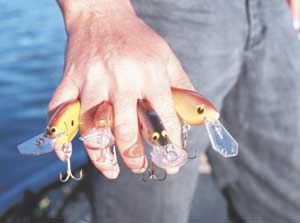
Fourteen years ago next month, I wrote a newspaper column about flat-sided crankbaits after an afternoon excursion to High Rock Lake with the late Jerry Walters of Lexington, a fine bass fisherman who lost a battle with cancer several years ago at far too young an age. I found a copy of the story other day while I was going through my files in search of some other old notes. Actually, I found a slide of Jerry’s hand holding a real handful of flat baits. When I picked it up off the floor — it had fallen out of its plastic protective sheet – I remembered how much Jerry liked fishing flat-sided baits in the fall, and that’s how column ideas like this one somehow evolve.
I broke out the file holding the old notes I took and the story that ran that fall. What he said in 1992 holds pretty much true in 2006 — flat-sided crankbaits are real bass producers when the leaves start to change color and fall.
“Bass are following shad, and a flat-sided bait is just about the same size as the baitfish are at that time of the year,” Walters said. “The majority of the time a bass locates a baitfish with his lateral lines … He feels the baitfish coming through the water by using his lateral lines.
“Bass can feel a flat-sided bait because of the amount of water it’s pushing as it wobbles. It causes the fish to react better, more like it’s a real baitfish.
“I’ve had a bass to chase the lure and miss it, then knock two shad out of the water, then get back on the bait. That tells me that they can’t tell the difference between the bait and a baitfish.”
Three veteran bass fishermen — David Fritts and Maynard Edwards of Walters’ hometown, Lexington, and Joel Richardson of Kernersville — I talked with about flat-sided plugs said many of the same things.
Fritts and Richardson are bass pros; Edwards guides at High Rock, Tuckertown and Badin lakes when he’s not hanging out in his high-school classroom, teaching kids the difference between a C-drive and a floppy disk.
Fritts recently helped Rapala develop a flat-sided addition to its successful line of DT (Down To) crankbaits.
“Flat baits have a little bit wider wobble, and because fish are more aggressive in the fall, that’s fine,” he said. “A flat bait will have a good roll, and it’s a bait for more aggressive fish; it will trigger a lot of strikes.
“We worked really hard to get the DT-Flat just right, and it’s an excellent bait when bass move out of deep water in the fall.”
Edwards said the wide wobble means everything to a flat-sided bait’s success.
“I like to fish a bait that puts off a lot of vibration in the fall, and the little, short, flat-billed baits seem to work better – a (Bomber) Flat A, a (Bill Norman) Little Scooper – those baits up off a lot of vibration,” he said.
“Fish are actively feeding in the fall, and they’ll move a long way to attack a bait. That’s a reason that a buzzbait works so well in the fall — it creates a disturbance that will attract bass. I think sometimes they can feel a bait coming through the water, and they’ll go after it.”
Edwards doesn’t fish flat-sided baits more than 5- or 6- feet deep, so the smallish baits with coffin bills are perfect for him. Richardson likes them in the fall because he can fish them fast without harming the bait’s natural action.
“I think they key in on the action,” he said. “A flat bait has always been a great bait in the fall — and it’s good in the spring, too.”
Richardson has always felt, however, that flat-sided baits with round bills work better.
“To me, a bait with a coffin bill pulls harder,” he said. “I move more water and get a wider wobble with a bait that has a round bill. And I don’t think a bait with a round bill will hand up as much.”
When flat-sided baits drew his attention, Walters was interested in trying to make a flat-sided bait with a big bill that would dive deeper but have the same action as a small, shallow-running bait.
Jerry Lohr, another Lexington bass-lure wizard, solved that riddle with his Lohr Lures, deep-diving plugs with flat sides. One problem was, most crankbaits were made of balsa wood in the 1980s and 1990s.
A light, flat bait tends to really flutter in the wind on a long cast, costing fishermen distance. But heavier baits made of cedar and banac tended to iron out that problem.
Still, flat baits are mostly used in shallow-water applications in the fall.
“You can fish them around anything — visible cover like a laydown, or stuff that’s underwater like rocks and stumps,” Richardson said. “I really like a Flat-A, and I like the flat-sided baits that James Marshall (owner of “On The Line: crankbaits) makes. I think they’re called DJ-T baits. And there are a lot of flat-sided baits out there that are sort of custom made.”
The key is that they’re easy baits to fish.
“All you’ve got to do,” Walters said in 1992, “is find a place where there are some shad. I like to look for birds — gulls. Usually, you see them out over the channel, but if you see them over shallow water, you know the shad are in close to the bank. And you can throw a flat bait up there and catch bass.”




Be the first to comment